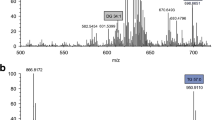Abstract
Wax esters (WE) are one of the predominant lipid types in human meibomian gland secretions (meibum) and account for 40–50 % of total meibum lipids. Recently, we managed to quantify 51 isomeric groups of intact WE in normal human meibum samples by direct infusion electrospray ionization mass spectrometry (ESI–MS), with each WE peak in the MS spectrum corresponding to one isomeric group (Chen et al, Invest Ophthalmol Vis Sci 54(8):5730–53, 2013). However, the information of the isomeric composition in each group was not obtained. In this study, tandem mass spectrometry (MS/MS) was applied to quantify relative amounts of these isomers using the intensities of the corresponding diagnostic ions after appropriate correction and normalization. This data was combined with the previous obtained mole fraction of each isomeric group to total WE in human meibum to determine the corresponding percentage of each isomer. A total of 23 of the most abundant WE peaks of different molecular weights (corresponding to 85.3 % of the total amount of WE) in human meibum were studied and resulted in quantification of 92 WE species. The quantitative information of composition of WE in human meibum will help better understand their role in the tear film.





Similar content being viewed by others
Abbreviations
- CE:
-
Cholesteryl ester
- CI:
-
Chemical ionization
- CID:
-
Collision-induced dissociation
- EI:
-
Electron ionization
- ESI:
-
Electrospray ionization
- FA:
-
Fatty acid
- FAl:
-
Fatty alcohol
- FID:
-
Flame ionization detector
- GC:
-
Gas chromatography
- LC:
-
Liquid chromatography
- MS:
-
Mass spectrometry
- MS/MS:
-
Tandem mass spectrometry
- TFLL:
-
Tear film lipid layer
- WE:
-
Wax ester
References
Knop E, Knop N, Millar T, Obata H, Sullivan DA (2011) The international workshop on meibomian gland dysfunction: report of the subcommittee on anatomy, physiology, and pathophysiology of the meibomian gland. Invest Ophthalmol Vis Sci 52:1938–1978
Butovich IA, Arciniega JC, Lu H, Molai M (2012) Evaluation and quantitation of intact wax esters of human meibum by gas-liquid chromatography-ion trap mass spectrometry. Invest Ophthalmol Vis Sci 53:3766–3781
Chen J, Green KB, Nichols KK (2013) Quantitative profiling of major neutral lipid classes in human meibum by direct infusion electrospray ionization mass spectrometry. Invest Ophthalmol Vis Sci 54:5730–5753
Mathers WD, Lane JA (1998) Meibomian gland lipids, evaporation, and tear film stability. Adv Exp Med Biol 438:349–360
Lam SM, Tong L, Duan X, Petznick A, Wenk MR, Shui G (2014) Extensive characterization of human tear fluid collected using different techniques unravels the presence of novel lipid amphiphiles. J Lipid Res 55:289–298
Brown SH, Kunnen CM, Duchoslav E, Dolla NK, Kelso MJ, Papas EB, Lazon de la Jara P, Willcox MD, Blanksby SJ, Mitchell TW (2013) A comparison of patient matched meibum and tear lipidomes. Invest Ophthalmol Vis Sci 54:7417–7424
Lam SM, Tong L, Yong SS, Li B, Chaurasia SS, Shui G, Wenk MR (2011) Meibum lipid composition in Asians with dry eye disease. PLoS One 6:e24339
Nicolaides N, Kaitaranta JK, Rawdah TN, Macy JI, Boswell FM 3rd, Smith RE (1981) Meibomian gland studies: comparison of steer and human lipids. Invest Ophthalmol Vis Sci 20:522–536
Sullivan BD, Evans JE, Cermak JM, Krenzer KL, Dana MR, Sullivan DA (2002) Complete androgen insensitivity syndrome: effect on human meibomian gland secretions. Arch Ophthalmol 120:1689–1699
Butovich IA, Wojtowicz JC, Molai M (2009) Human tear film and meibum. Very long chain wax esters and (O-acyl)-omega-hydroxy fatty acids of meibum. J Lipid Res 50:2471–2485
Chen JZ, Green-Church KB, Nichols KK (2010) Shotgun lipidomic analysis of human meibomian gland secretions with electrospray ionization tandem mass spectrometry. Invest Ophthalmol Vis Sci 51:6220–6231
Lam SM, Tong L, Reux B, Lear MJ, Wenk MR, Shui GH (2013) Rapid and sensitive profiling of tear wax ester species using high performance liquid chromatography coupled with tandem mass spectrometry. J Chromatogr A 1308:166–171
Chen J, Green KB, Nichols KK (2015) Characterization of wax esters by electrospray ionization tandem mass spectrometry: double bond effect and unusual product ions. Lipids 50:821–836
Fitzgerald M, Murphy RC (2007) Electrospray mass spectrometry of human hair wax esters. J Lipid Res 48:1231–1246
Rockwood AL, Haimi P (2006) Efficient calculation of accurate masses of isotopic peaks. J Am Soc Mass Spectrom 17:415–419
Aasen AJ, Hofstett HH, Iyengar BTR, Holman RT (1971) Identification and analysis of wax esters by mass spectrometry. Lipids 6:502–507
Spencer GF (1979) Alkoxy-acyl combinations in the wax esters from winterized sperm whale oil by gas chromatography-mass spectrometry. J Am Oil Chem Soc 56:642–646
Spencer GF, Plattner RD (1984) Compositional analysis of natural wax ester mixtures by tandem mass-spectrometry. J Am Oil Chem Soc 61:90–94
Tava A, Cunico C, Cremona R, Piccinini E (1996) Isomeric composition of the ester fraction from epicuticular waxes of Festuca arundinacea Schreb. J High Res Chromatogr HRC 19:6
Han X, Yang K, Gross RW (2012) Multi-dimensional mass spectrometry-based shotgun lipidomics and novel strategies for lipidomic analyses. Mass Spectrom Rev 31:134–178
Saville JT, Zhao Z, Willcox MD, Ariyavidana MA, Blanksby SJ, Mitchell TW (2011) Identification of phospholipids in human meibum by nano-electrospray ionisation tandem mass spectrometry. Exp Eye Res 92:238–240
Iven T, Herrfurth C, Hornung E, Heilmann M, Hofvander P, Stymne S, Zhu LH, Feussner I (2013) Wax ester profiling of seed oil by nano-electrospray ionization tandem mass spectrometry. Plant Methods 9:24
Han X, Gross RW (2001) Quantitative analysis and molecular species fingerprinting of triacylglyceride molecular species directly from lipid extracts of biological samples by electrospray ionization tandem mass spectrometry. Anal Biochem 295:88–100
Koivusalo M, Haimi P, Heikinheimo L, Kostiainen R, Somerharju P (2001) Quantitative determination of phospholipid compositions by ESI–MS: effects of acyl chain length, unsaturation, and lipid concentration on instrument response. J Lipid Res 42:663–672
Zhou S, Hamburger M (1995) Effects of solvent composition on molecular ion response in electrospray mass spectrometry: investigation of the ionization processes. Rapid Commun Mass Spectrom 9:1516–1521
La Mer VK, Healy TW, Aylmore LAG (1964) The transport of water through monolayers of long-chain n-paraffinic alcohols. J Coll Sci 19:673–684
Archer RJ, Mer VKLA (1955) The rate of evaporation of water through fatty acid monolayers. J Phys Chem 59:200–208
Mer VK, Healy TW (1964) Specification of materials for the retardation of evaporation of water-the spreading of hexadecanol monolayers. Proc Natl Acad Sci USA 52:679–683
King-Smith PE, Bailey MD, Braun RJ (2013) Four characteristics and a model of an effective tear film lipid layer (TFLL). Ocul Surf 11:236–245
Patel S, Nelson DR, Gibbs AG (2001) Chemical and physical analyses of wax ester properties. J Insect Sci 1:4
Borchman D, Foulks GN, Yappert MC, Bell J, Wells E, Neravetla S, Greenstone V (2011) Human meibum lipid conformation and thermodynamic changes with meibomian-gland dysfunction. Invest Ophthalmol Vis Sci 52:3805–3817
Boese R, Weiss HC, Blaser D (1999) The melting point alternation in the short-chain n-Alkanes: single-crystal X-ray analyses of propane at 30 K and of n-butane to n-nonane at 90 K. Angew Chem 38:4
Iyengar BT, Schlenk H (1969) Melting points of synthetic wax esters. Lipids 4:28–30
Dunn RO, Dunn RO (2009) A comprehensive evaluation of the melting points of fatty acids and esters determined by differential scanning calorimetry. J Am Oil Chem Soc 86:843–856
Yao L, Hammond EG (2006) Isolation and melting properties of branched-chain esters from lanolin. J Am Oil Chem Soc 83:547–552
Kulkarni MG, Sawant SB (2002) Physico-chemical properties of wax esters synthesised from corresponding alcohols using hydrobromic acid and hydrogen peroxide action. Eur J Lipid Sci Technol 104:387–393
Foulds EL Jr, Dressler RG (1968) Performance of monolayer blends of odd and even carbon chain alcohols in water evaporation suppression. Ind Eng Chem Prod RD 7:75–79
Acknowledgments
The authors thank NIH for funding (Grant Number: NEI R01EY015519, KKN) and Jeremy Keirsey at the Campus Chemical Instrument Center of the Ohio State University for critical comments and proofreading.
Author information
Authors and Affiliations
Corresponding author
About this article
Cite this article
Chen, J., Green, K.B. & Nichols, K.K. Compositional Analysis of Wax Esters in Human Meibomian Gland Secretions by Direct Infusion Electrospray Ionization Mass Spectrometry. Lipids 51, 1269–1287 (2016). https://doi.org/10.1007/s11745-016-4183-4
Received:
Accepted:
Published:
Issue Date:
DOI: https://doi.org/10.1007/s11745-016-4183-4




